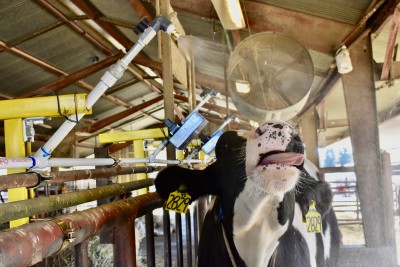Considerations for identifying and abating heat load in cattle
Alycia Drwencke, Dairy Management Specialist
Southwest New York Dairy, Livestock and Field Crops Program

Considerations for identifying and abating heat load in cattle
While winter held out as long as it could, spring has arrived in a hurry and with it, much warmer temperatures. These increased temperatures are great for planting fields and harvesting forage, but are less ideal for our cattle. Cattle have a much lower thermal comfort zone than humans do, and are highly susceptible to heat stress, which can result in production losses, reduced fertility, lameness, and in severe cases, mortality. The effects of heat stress on lactating dairy cows has been widely accepted, however, a growing body of evidence shows the importance of providing cooling or heat abatement to young stock and dry cows too. For your existing heat abatement, performing regular and simple maintenance and monitoring animals for cow-based indicators can improve the efficiency of your cooling and increase profitability.
Spring is a busy time on the dairy, which can make it difficult to prioritize regular maintenance of heat abatement, but these simple tasks can help save you money on electricity and water, and help cool cows more effectively. Fans that have dust and debris build up can have a reduced efficiency of 30-50%. Taking a few minutes to clean fans can help you regain this energy efficiency. Additionally, replacing and repairing any broken or leaking spray water nozzles can reduce water wastage. It is also important to prioritize repairing any damaged shade structures as this is the most basic protection from heat. Shade is beneficial for all ages and classes of animals and can improve the profitability of your herd.
Traditionally, weather or air temperature has been the basis for when heat abatement is provided. However, research shows that humidity, wind speed, night time temperatures, and previous experience influence the ability of cows to cope with increased heat load. Using a temperature-humidity index of 68 as an indicator of when cows begin to experience increased heat loads is a good start, but it should not be the sole indicator used for determining thermal comfort. Cows should be monitored for signs of increased heat load or heat stress as well.
Cow-based measures are ideal for identifying heat load, as they can provide individualized results, and describe how they are experiencing an environment. Often, decreases in milk production and fertility are used as indicators of heat stress, but these are only identified after the problem has occurred. Once production losses occur, there is no going back in time to better cool those cows. As heat load increases, cows also exhibit elevated body temperature and respiration rates, as well as panting. These measures give us more timely information, but can be difficult to monitor in a production system. As heat load increases, cows will also increase the amount of time they spend standing, particularly near a water trough or a shaded soaker line, and decrease their time spent eating and ruminating. Some accelerometer based monitoring systems can help identify these changes in behavior and physiological status. Although, it is beneficial to understand the accuracy of these technologies as it can vary. Routine manual observation should also be incorporated to regular chores such as feeding, breeding, fetching for milking, etc. to help detect increases in heat load earlier in the progression.
Together, proving shade and appropriate heat abatement to animals on your farm can help promote profitability in your herd. By performing regular maintenance to existing heat abatement, efficiency of those technologies can be improved and help better cool cattle. To learn more about heat abatement efficiency and utilizing cow-based indicators, reach out to our Dairy Management Specialist, Alycia Drwencke.
Upcoming Events
WEBINAR - Automated Milking Systems Efficiency: Balancing Focus on Individual Cows and System Optimization
May 8, 2024
Please join Cornell the SWNY team and MSU Extension for our talk with Dr. Pablo Silva Boloña on improving efficiency of Automated milking systems by focusing on milking settings for individual and group success.
Broiler Field Day at Sunny Cove Farm
June 6, 2024
Alfred Station, NY
Join us for a field day to explore broiler production, processing, and finances. Meghan Snyder of Sunny Cove Farm will be our host. She raises small batches of organic broilers, processing them on-farm under the 1,000 bird exemption.
Stockmanship and Stewardship 2024
October 25, 2024
Hamburg, NY
Save the date!! The event is one of 4 across the US and is a two-day educational experience featuring low-stress cattle handling demonstrations, Beef Quality Assurance educational sessions, facility design sessions, and industry updates.
Announcements
No announcements at this time.





